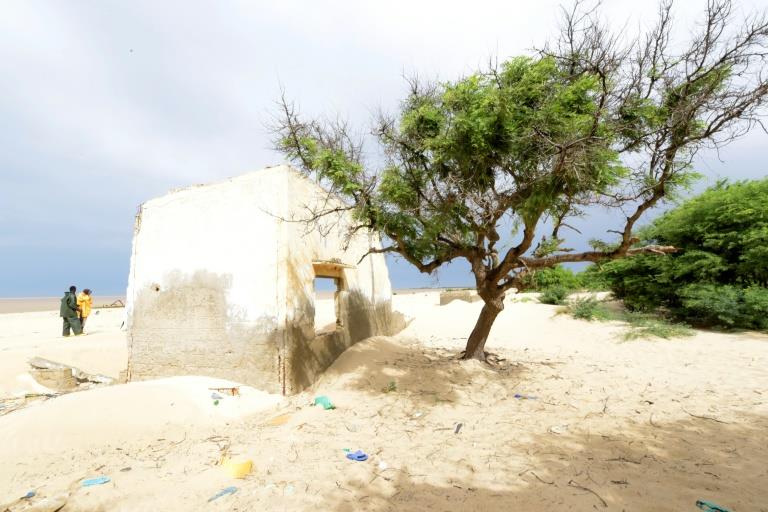
Climate change and neglect threaten Senegal's Saint Louis
Listed in 2000 as a UNESCO world heritage site, Saint Louis has fallen into disrepair, and without urgent intervention more than 300 years of colonial history could be lost.
Beautifully coloured buildings with colonial facades line the streets of the city, once known as "Africa's Venice", but on closer inspection many are crumbling. Others that look on to the beach succumb to Atlantic waves.
And at the cathedral, large sections of plaster peel from the walls and float to the earth.
"It's dramatic and it could become extremely serious," said French Foreign Affairs Minister Jean-Yves Le Drian on a visit Tuesday to what was once the Senegalese capital, and where the first French chartered company set up shop in 1659.
On a thin, sandy strip separating the Senegal River from the ocean, the effects of rising sea levels driven by climate change are clear.
Abdoulaye Mben Khali School was forced to relocate eight year groups to another establishment, Cheikh Ndar, itself just 50 metres away on the seafront and also under threat from the waves, explained Saint Louis governor Mariama Traore.
Meanwhile more than 150 families have lost their homes in recent years, several during the height of the storms of Senegal's rainy season in September.
They are now living in tents near the city's tiny airport.
- Fightback -
Senegalese President Macky Sall left the capital, Dakar, on Tuesday to attend a UN Climate Change Conference in Bonn, Germany, where developing nations will repeat longstanding calls for the world's biggest economies to respect agreements on lowering greenhouse gas emissions from burning fossil fuels.
This week, Syria became the 196th country to formally adopt the hard-fought Paris Agreement, signed in 2016, leaving the United States as the only nation in the UN climate convention to reject it.
The Paris Agreement commits countries to limiting average global warming to under two degrees Celsius (3.6 degrees Fahrenheit) over Industrial Revolution levels, and 1.5 C if possible, to avert calamitous climate change-induced storms, drought and sea-level rises.
Away from the corridors of international diplomacy, the World Bank is conducting a study on the city and its battle against climate change at the behest of the Senegalese authorities.
"I hope the conclusion will come through quickly because we must draw up an action plan," France's Le Drian noted as he toured the city's winding alleys.
Meanwhile work is due to begin imminently on a 3.6-kilometre (2.2-mile) long dyke to protect the city's most heavily populated neighbourhoods.
Other symbols of France's colonial past in Senegal, which ended with independence in 1960, have created serious debate.
When a bronze statue of Louis Faidherbe, governor of Senegal between 1854-1861 and then 1863-1865, fell from its pedestal in the town square during September's storms, some said good riddance.
But the Senegalese authorities ultimately decided the statue counted as heritage nonetheless and was therefore to be protected, against the cries of pandering to the preservation of colonialism.
The square where Faidherbe was resurrected was supposed to be renovated to the tune of 24.5 million euros ($29 million) by France's development agency, but despite approval in 2011 work has yet to begin.

Legal Disclaimer:
MENAFN provides the information “as is” without warranty of any kind. We do not accept any responsibility or liability for the accuracy, content, images, videos, licenses, completeness, legality, or reliability of the information contained in this article. If you have any complaints or copyright issues related to this article, kindly contact the provider above.
Most popular stories
Market Research

- Manuka Honey Market Report 2024, Industry Growth, Size, Share, Top Compan...
- Modular Kitchen Market 2024, Industry Growth, Share, Size, Key Players An...
- Acrylamide Production Cost Analysis Report: A Comprehensive Assessment Of...
- Fish Sauce Market 2024, Industry Trends, Growth, Demand And Analysis Repo...
- Australia Foreign Exchange Market Size, Growth, Industry Demand And Forec...
- Cold Pressed Oil Market Trends 2024, Leading Companies Share, Size And Fo...
- Pasta Sauce Market 2024, Industry Growth, Share, Size, Key Players Analys...





















Comments
No comment